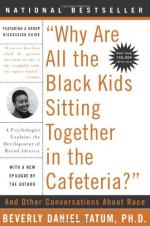
|
| Name: _________________________ | Period: ___________________ |
This test consists of 15 multiple choice questions and 5 short answer questions.
Multiple Choice Questions
1. What refers to a personally offensive act or word; deliberate act or display of disrespect?
(a) Euthanize.
(b) Default.
(c) Affront.
(d) Virtue.
2. Why did Tatum's son assume a black boy was running down the street in an example given in Part II, Understanding Blackness in a White Context, Chapter 3?
(a) He had stabbed somebody.
(b) He had stolen something.
(c) He was late for work.
(d) The cops were chasing him.
3. Tatum writes that much of the attraction of the Nation of Islam to black men is that it offers them what?
(a) An escape from their otherness.
(b) A vision of the truth.
(c) A conception of Blackness that is empowering.
(d) An ability to intermarry.
4. What refers to something used for or regarded as representing something else; a material object representing something, often something immaterial?
(a) Antagonist.
(b) Symbol.
(c) Catalyst.
(d) Lingual.
5. What means extended or arranged in a line?
(a) Circular.
(b) Perpendicular.
(c) Linear.
(d) Jugular.
6. Oppositional identities interfere with what, according to the author in Part II, Understanding Blackness in a White Context, Chapter 4, Identity Development in Adolescence?
(a) Achievement.
(b) Sexual development.
(c) Raising children.
(d) Workplace relationships.
7. What is the fifth stage of William E. Cross, Jr.'s theory of Nigrescence?
(a) Pre-encounter.
(b) Internalization.
(c) Internalization-commitment.
(d) Immersion/emersion.
8. While studying at university, Tatum had what Cross describes as what kind of experience?
(a) Conversion.
(b) Nationalism.
(c) Adversion.
(d) Immersion.
9. What refers to something accomplished, especially by superior ability, special effort, great courage, etc.?
(a) Reality.
(b) Achievement.
(c) Bias.
(d) Contact.
10. Tatum writes in Part II, Understanding Blackness in a White Context, Chapter 3 that at very young ages, children are often confused by the color language due to their encounters with what?
(a) Dolls.
(b) Television.
(c) Other children.
(d) Crayons.
11. Tatum believes that self-segregation and declining academic achievement are the result of ___________.
(a) Popular culture.
(b) White power.
(c) An environment where blacks are dominant.
(d) A post-desegregation phenomenon.
12. What is the second stage of William E. Cross, Jr.'s theory of Nigrescence?
(a) Pre-encounter.
(b) Internalization.
(c) Immersion
(d) Encounter.
13. What is the first of Erik Erikson's life-stage virtues which is comprised of the first year of infancy?
(a) Hope.
(b) Fidelity.
(c) Will.
(d) Confidence.
14. Beverly Daniel Tatum earned her PhD in clinical psychology from which university?
(a) The CUNY Graduate Center.
(b) Boston College.
(c) The University of Michigan.
(d) Hartford Seminary.
15. What refers to a suspension of activity?
(a) Moratorium.
(b) Conflation.
(c) Adaptation.
(d) Diffusion.
Short Answer Questions
1. What refers to a particular tendency or inclination, especially one that prevents unprejudiced consideration of a question?
2. Tatum writes in Part II, Understanding Blackness in a White Context, Chapter 3 that often black children express self-rejection and internalized __________.
3. Tatum conceives of herself as both perceiving and _______ race.
4. What refers to opposition or resistance to an idea, plan, project, etc.?
5. What refers to the state of being withdrawn or isolated from the objective world, as through indifference or disaffection?
|
This section contains 464 words (approx. 2 pages at 300 words per page) |

|




